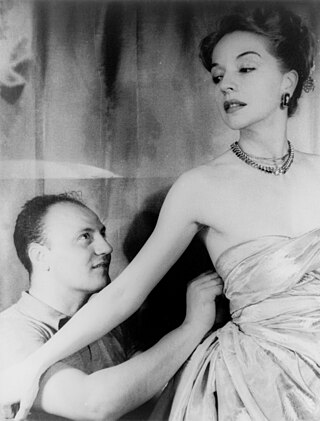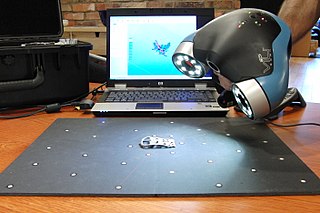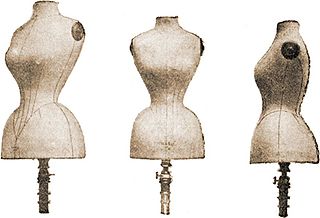
A dressmaker, also known as a seamstress, is a person who makes clothing for women, such as dresses, blouses, and evening gowns. Dressmakers were historically known as mantua-makers, and are also known as a modiste or fabrician.

3D scanning is the process of analyzing a real-world object or environment to collect three dimensional data of its shape and possibly its appearance. The collected data can then be used to construct digital 3D models.

A tracking system, also known as a locating system, is used for the observing of persons or objects on the move and supplying a timely ordered sequence of location data for further processing.

HerRoom is an online lingerie and men's underwear retailer based in Dallas, Texas. It was founded and is owned by Tomima Edmark, inventor of the TopsyTail. Edmark runs both HerRoom and brother site HisRoom, through her company, the Andra Group LLP.

Fashion design is the art of applying design, aesthetics, clothing construction and natural beauty to clothing and its accessories. It is influenced by culture and different trends, and has varied over time and place. "A fashion designer creates clothing, including dresses, suits, pants, and skirts, and accessories like shoes and handbags, for consumers. He or she can specialize in clothing, accessory, or jewelry design, or may work in more than one of these areas."
Made-to-measure (MTM) typically refers to custom clothing that is cut and sewn using a standard-sized base pattern. Suits and sport coats are the most common garments made-to-measure. The fit of a made-to-measure garment is expected to be superior to that of a ready-to-wear garment because made-to-measure garments are constructed to fit each customer individually based on a few body measurements to customize the pre-existing pattern. Made-to-measure garments always involve some form of standardization in the pattern and manufacturing, whereas bespoke tailoring is entirely made from scratch based on a customer's specifications with far more attention to minute fit details and using multiple fittings during the construction process. All else being equal, a made-to-measure garment will be more expensive than a ready-to-wear garment but cheaper than a bespoke one. "Custom made" most often refers to MTM.

A dress form is a three-dimensional model of the human torso used for fitting clothing that is being designed or sewed. When making a piece of clothing, it can be put on the dress form so that one can see the fit and drape of the garment as it would appear on a body and make adjustments or alterations. Dress forms come in all sizes and shapes for almost every article of clothing that can be made. Dress forms in the standard clothing sizes are used to make patterns, while adjustable dress forms allow garments to be tailored to fit a specific individual.
A fit model is a person who is used by a fashion designer or clothing manufacturer to check the fit, drape and visual appearance of a design on a 'real' human being, effectively acting as a live mannequin. A person is selected to work as a fitting model primarily on criteria matching the desired measurement specifications of the designer or manufacturer. These specifications generally consist of height, bust-waist-hip circumference, arm and leg length, shoulder width, and a myriad other measurements as indicated by the garment type. This is the case whether the garments are for women or men of any size; the grading of construction patterns is often tested on a variety of fitting models to be sure that increases in size are translated accurately and evenly across the range.
Advanced Fashion Design and Technology is a fashion-related manufacturing process that integrates new technologies.
ModCloth is a Los Angeles based online retailer of indie and vintage-inspired women’s clothing.
Clothing technology involves the manufacturing, materials - innovations that have been developed and used. The timeline of clothing and textiles technology includes major changes in the manufacture and distribution of clothing.

PrimeSense was an Israeli 3D sensing company based in Tel Aviv. PrimeSense had offices in Israel, North America, Japan, Singapore, Korea, China and Taiwan. PrimeSense was bought by Apple Inc. for $360 million on November 24, 2013.
VenueGen is a browser-based web conferencing service created and marketed by The Venue Network. It is a 3D virtual meeting software that enables users to interact with each other using avatars. Users can host and attend meetings, conferences, and training with other colleagues and upload rich media into virtual meeting rooms for real-time collaboration.
'Fast fit refers to a method of handling the shipping and sampling processes typical of multinational organizations who primarily manufacture offshore, specifically in the fashion and textile industry. The Fast Fit philosophy centers on the sharing of 360-degree, annotatable images intended to reduce the costs and lead times associated with shipping physical samples. The term is particularly prevalent among companies that fit the Fast Fashion model, as Fast Fit is considered to be a vital component in the reduction of time between design inspiration and final production of a garment or product.
The Webcam Social Shopper, often referred to as virtual dressing room software, debuted online in June 2009 and was created by Los Angeles–based software company, Zugara. Cited initially as an "augmented reality dressing room", The Webcam Social Shopper allows online shoppers to use a webcam to visualize virtual garments on themselves while shopping online. The software also uses a motion capture system that allows users to use hand motions to navigate the software while standing back from their computer. Social media integration with Facebook and Twitter also allows users of the software to send pictures of themselves with the virtual garments for immediate feedback.
Alton Lane is an American menswear company founded in 2009 by Colin Hunter and Peyton Jenkins, graduates of the University of Virginia. Alton Lane offers modern bespoke suits, blazers, trousers, tuxedos, and shirts. The company is headquartered in Richmond, Virginia, and its suits are produced in Germany, Italy, and Thailand. Alton lane uses a combination of 3D body scanners and hand measurements to produce fully custom clothing.

Digital Fashion is the visual representation of clothing built using computer technologies and 3D software. This industry is on the rise due to ethical awareness and uses of digital fashion technology such as artificial intelligence to create products with complex social and technical software.

A virtual mirror or smart mirror is a device that displays a user's own image on a screen as if that screen were a mirror. Some versions feature augmented reality additions to the video display, or use an entirely virtual graphical avatar of the user.

3D body scanning is an application of various technologies such as Structured-light 3D scanner, 3D depth sensing, stereoscopic vision and others for ergonomic and anthropometric investigation of the human form as a point-cloud. The technology and practice within research has found 3D body scanning measurement extraction methodologies to be comparable to traditional anthropometric measurement techniques.
Commercial augmented reality (CAR) describes augmented reality (AR) applications that support various B2B (Business-to-Business) and B2C (Business-to-Consumer) commercial activities, particularly for the retail industry. The use of CAR started in 2010 with virtual dressing rooms for E-commerce.









